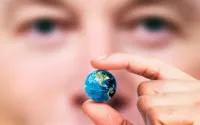Common Dreams - Published on Thursday, October 19, 2006 by ReutersDaniel Wallis
The number of "dead zones" in the world's oceans may have increased by a third in just two years, threatening fish stocks and the people who depend on them, the U.N. Environment Program said on Thursday.
 NUMBER OF DEAD ZONES RISING FASTPatches of plant life are surrounded by water from the Gulf of Mexico near Pilottown, Louisiana, south of New Orleans July 26, 2006. The number of 'dead zones' in the world's oceans may have increased by a third in just two years, threatening fish stocks and the people who depend on them, the U.N. Environment Program said on Thursday. Today, the best known is in the Gulf of Mexico, where fertilizers and other algae-multiplying nutrients are dumped by the Mississippi River. (Lee Celano/Reuters) NUMBER OF DEAD ZONES RISING FASTPatches of plant life are surrounded by water from the Gulf of Mexico near Pilottown, Louisiana, south of New Orleans July 26, 2006. The number of 'dead zones' in the world's oceans may have increased by a third in just two years, threatening fish stocks and the people who depend on them, the U.N. Environment Program said on Thursday. Today, the best known is in the Gulf of Mexico, where fertilizers and other algae-multiplying nutrients are dumped by the Mississippi River. (Lee Celano/Reuters) |
Now experts estimate there are 200 so-called ocean dead zones, compared with 150 two years ago.
"Some successes are being scored but in other areas -- like sewage, nutrients from fertilizer run off, animal wastes and atmospheric pollution; sediment mobilization and marine litter -- the problems are intensifying," UNEP Executive Director Achim Steiner said in a statement.
The first "dead zones" -- where pollution-fed algae remove oxygen from the water -- were found in northern latitudes like the Chesapeake Bay on the U.S. East Coast and the Scandinavian fjords.
Today, the best known is in the Gulf of Mexico, where fertilizers and other algae-multiplying nutrients are dumped by the Mississippi River.
Others have been appearing off South America, Ghana, China, Japan, Australia, New Zealand, Portugal and Britain.
The UNEP said in a statement that experts warn "these areas are fast becoming major threats to fish stocks and thus to the people who depend upon fisheries for food and livelihoods."
The full list is expected to be published early next year, but the preliminary findings were released on Thursday at an international marine pollution conference in Beijing, China, which gathered delegates from more than 100 nations.
The meeting also heard some good news from scientists studying the recovery rates of coral reefs damaged by bleaching in the late 1990s by high sea temperatures.
Coral reefs get bleached when warm water forces out tiny algae that live in the coral, providing nutrients and giving reefs their vivid colors. Without the algae, corals whiten and eventually die.
"The new studies indicate healthy ecosystems exposed to minimal contamination are likely to recover and survive better than those stressed by pollution, dredging and other human-made impacts," Steiner said.
UNEP said the overall findings were given even more urgency by new modeling that shows up to 90 percent of the world's tropical coasts may be developed by 2030.
"Climate change, and the need to build resilience into habitats and ecosystems so they can cope with the anticipated increase in temperatures likely to come, now represents a further urgent reason to act," Steiner added
Thursday's meeting came just over two weeks before the start of global warming talks under the U.N. Framework Convention on Climate Change due to begin in Nairobi, Kenya on November 6.






